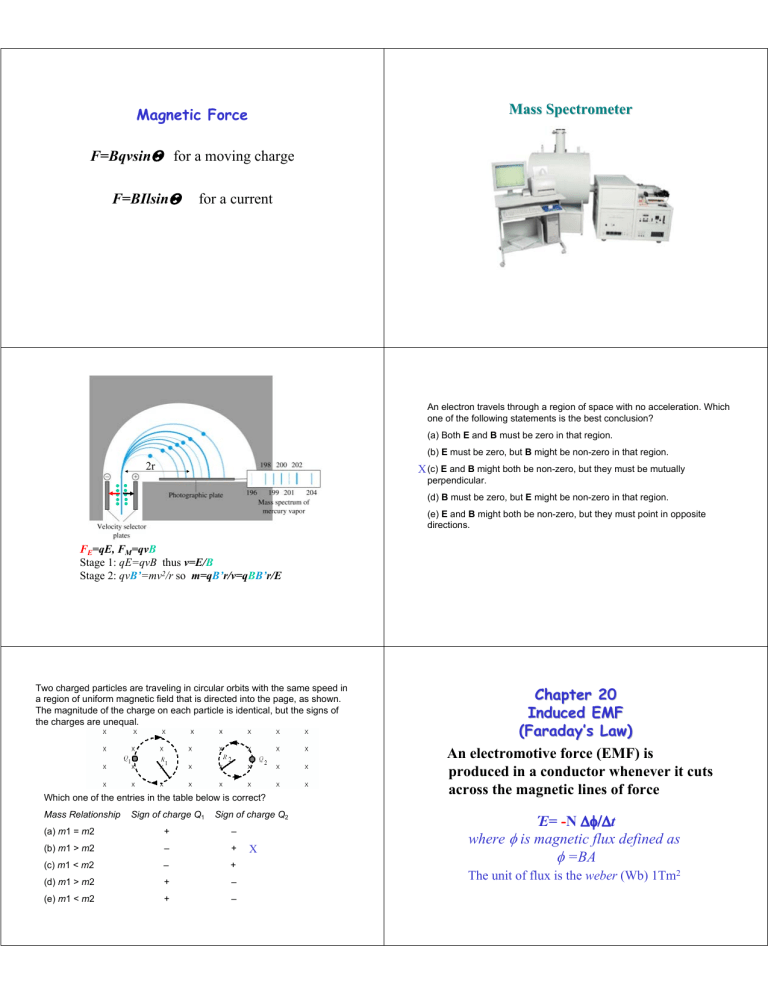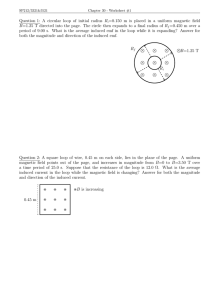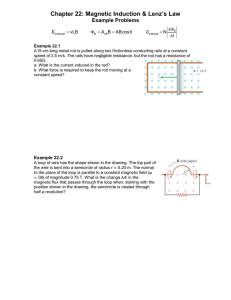φ =BA
advertisement

Mass Spectrometer Magnetic Force F=BqvsinΘ for a moving charge F=BIlsinΘ for a current An electron travels through a region of space with no acceleration. Which one of the following statements is the best conclusion? (a) Both E and B must be zero in that region. (b) E must be zero, but B might be non-zero in that region. 2r X (c) E and B might both be non-zero, but they must be mutually ••••• ••••• perpendicular. (d) B must be zero, but E might be non-zero in that region. (e) E and B might both be non-zero, but they must point in opposite directions. FE=qE, FM=qvB Stage 1: qE=qvB thus v=E/B Stage 2: qvB’=mv2/r so m=qB’r/v=qBB’r/E Two charged particles are traveling in circular orbits with the same speed in a region of uniform magnetic field that is directed into the page, as shown. The magnitude of the charge on each particle is identical, but the signs of the charges are unequal. Which one of the entries in the table below is correct? Mass Relationship Sign of charge Q1 Sign of charge Q2 (a) m1 = m2 + – (b) m1 > m2 – + (c) m1 < m2 – + (d) m1 > m2 + – (e) m1 < m2 + – X Chapter 20 Induced EMF (Faraday’s Law) An electromotive force (EMF) is produced in a conductor whenever it cuts across the magnetic lines of force Έ= -N Δφ/Δt where φ is magnetic flux defined as φ =BA The unit of flux is the weber (Wb) 1Tm2 Electric current generates magnetic field B=μoI/2πr v S B=μoI/2r N > v I B r > > < < × B r B Induced current I I Induced I Right hand rule determines the direction of the induced current Lenz’s Law An induced emf always yields a current whose induced magnetic field opposes the original change in flux. EMF Induced in Moving Conductor Motional EMF=ΔΦB/Δt=BΔ =BΔA/Δ A/Δt=BlvΔ lvΔt/Δ t/Δt=Blv Bex ×××××××××××××××××××× ×××××××××××××××××××× •• •• ×××××××××××××××××××× •• •• l I ×××××××××××××××××××× •• •• v ×××××××××××××××××××× Bin ×××××××××××××××××××× vΔt Magnetic field induced Bin is in opposite direction to the external field Bex Why and How is emf generated? Magnetic force on a moving charge: F=BQvsinΘ Question: Electromotive force (emf) is most closely related to (a) electric field (b) magnetic field (c) potential difference (d) mechanical force Answer: c Question: A bar magnet is passed through a coil of wire. The induced current is greater when (a) the magnet moves slowly, so that it is inside the coil for a long time (b) the magnet moves fast, so that it is inside the coil for a short time (c) the north pole of the magnet enters the coil first (d) the south pole of the magnet enters the coil first Answer: b Question: A wire loop is moved parallel to a uniform magnetic field. The induced emf in the loop (a) depends on the area of the loop (b) depends on the shape of the loop (c) depends on the magnitude of the field (d) is 0 Question: The magnetic flux through a wire loop in a magnetic field B does not depend on (a) the area of the loop (b) the shape of the loop (c) the angle between the plane of the loop and the direction of B (d) the magnitude B of the field Answer: b A long, straight wire is in the same plane as a wooden, nonconducting loop. The wire carries an increasing current I in the direction shown in the figure. (a) There will be no induced emf and no induced current. (b) There will be a counterclockwise induced emf, but no induced current.X (c) There will be a clockwise induced emf, but no induced current. (d) There will be a clockwise induced current in the loop. (e) There will be a counterclockwise induced current in the loop. Answer: d A long, straight wire is in the same plane as a rectangular, conducting loop.The wire carries a constant current I as shown in the figure. Which one of the following statements is true if the wire is suddenly moved toward the loop? (a) There will be no induced emf and no induced current. A metal ring is dropped from rest below a bar magnet that is fixed in position as suggested in the figure. An observer views the ring from below. Which one of the following statements concerning this situation is true? (b) There will be an induced emf, but no induced current. (a) As the ring falls, an induced current will flow counterclockwise as viewed by the observer. X (c) There will be an induced current that is clockwise around the loop. (b) As the ring falls, an induced current will flow clockwise as viewed by the observer. (d) There will be an induced current that is counterclockwise around the loop. X (c) As the ring falls, there will be an induced magnetic field around the ring that appears counterclockwise as viewed by the observer. (e) There will be an induced electric field that is clockwise around the loop. (d) As the ring falls, there will be an induced magnetic field around the ring that appears clockwise as viewed by the observer. (d) Since the magnet is stationary, there will be no induced current in the ring. Two conducting loops carry equal currents I in the same direction as shown in the figure. If the current in the upper loop suddenly drops to zero, what will happen to the current in the bottom loop according to Lenz’s law? (a) The current will decrease. A conducting bar moves to the left at a constant speed v on two conducting rails joined at the left as shown. As a result of the bar moving through a constant magnetic field, a current I is induced in the indicated direction. Which one of the following directions is that of the magnetic field? (b) The current will increase. X (a) toward the right (d) into the page (c) The current will not change. (b) toward the left (e) out of the page X (d) The current will also drop to zero. (c) parallel to the long axis of the bar (e) The current will reverse its direction. A sheet of copper is pulled at constant velocity v from a region that contains a uniform magnetic field. At the instant shown in the figure, the sheet is partially in and partially out of the field. The induced emf in the sheet leads to the eddy current shown. Which one of the following statements concerning the direction of the magnetic field is true? (a) The magnetic field points to the right. (b) The magnetic field points to the left. (c) The magnetic field points into the paper. (d) The magnetic field points out of the paper.X A 2.0-kg rod has a length of 1.0 m and a resistance of 4.0 Ω. It slides with constant speed down a pair of frictionless vertical conducting rails that are joined at the bottom. Other than the rod, the rest of the circuit is resistanceless. A uniform magnetic field of magnitude 3.0 T is perpendicular to the plane formed by the rod and the rails as shown. Determine the speed of the rod. (a) 0.38 m/s (d) 5.6 m/s (b) 0.90 m/s (e) 8.7 m/s X (c) 2.6 m/s (e) The direction of the magnetic field cannot be determined from the information given. Electric Field Generated by Changing Magnetic Flux Electric Generator E=F/q=qvB/q=vB Έ=NBAω NBAωsinω sinωt h l N S N Loop horizontal EMF=max EMF S Loop vertical EMF=0 Emax -Emax t Question: When a wire loop is rotated in a magnetic field, the direction of the induced emf changes once in each (a) ¼ revolution (b) ½ revolution (c) 1 revolution (d) 2 revolution Answer: b E=BlvsinΘ => E=2NBlvsinΘ=NBAω sinωt where Θ=ωt, v=ωr=ωh/2 Transformer Question: The emf produced by an acgenerated varies between Emax and (a) 0 (b) 1/2 Emax (c) -Emax (d) the back emf ¾ The output emf of a transformer may be greater or smaller than its input emf ¾ A transformer operates on ac Answer: c E1=N1Δφ/Δt E2=N2Δφ/Δt E1/E2=N1/N2 Electrical Power Transmission • When transmitting electric power over long distances, it is most economical to use high voltage and low current – Minimizes I2R power losses E1I1=E2I2 (power input=power output) So I1/I2=E2/E1=N2/N1 • In practice, voltage is stepped up to about 230 000 V at the generating station and stepped down to 20 000 V at the distribution station and finally to 120 V at the customer’s utility pole Question: Alternating current is the secondary coil of a transformer is induced by (a) a varying electric field (b) a varying magnetic field (c) the iron core of the transformer (d) motion of the primary Torque on a Current Loop DC motor Answer: b Top view @ & I × • b B r F I a/2 a/2 F & Side view F=IbB τ=F×r @ B F F Θ & B @ Side view Loop plane || B τ=Fa/2 + Fa/2 = Fa=IbBa=IBA where A=ab, the area of the loop Loop plane makes an angle Θ with B τ=IBAsinΘ (because a/2sinΘ) F F Loop plane makes a angle Θ with B B τ=0 & @ Side view A current loop in a magnetic field always tends to turn so that its plane becomes perpendicular to the field F QUICK QUIZ 20.1 The figure below is a graph of magnitude B versus time t for a magnetic field that passes through a fixed loop and is oriented perpendicular to the plane of the loop. Rank the magnitudes of the emf generated in the loop at the three instants indicated (a, b, c), from largest to smallest. QUICK QUIZ 20.1 ANSWER (b), (c), (a). At each instant, the magnitude of the induced emf is proportional to the rate of change of the magnetic field (hence, proportional to the slope of the curve shown on the graph). Question: A current-carrying wire is in a uniform magnetic field with the direction of the current the same as that of the field (a) There is a force on the wire that tends to move it parallel to the field (b) There is a force on the wire that tends to move it perpendicular to the field (c) There is a torque on the wire that tends to rotate it until it is perpendicular to the field (d) There is neither a force nor a torque on the wire Question: A current-carrying loop in a magnetic field always tends to rotate until the plane of the loop is (a) parallel to the field (b) perpendicular to the field (c) either parallel or perpendicular to the field, depending on the direction of the current (d) at a 45° angle with the field Answer: b Answer: d Question: The nature of the force responsible for the operation of an electric motor is (a) electric (b) magnetic (c) a combination of electric and magnetic (d) either electric or magnetic depending on the design of the motor Answer: b






